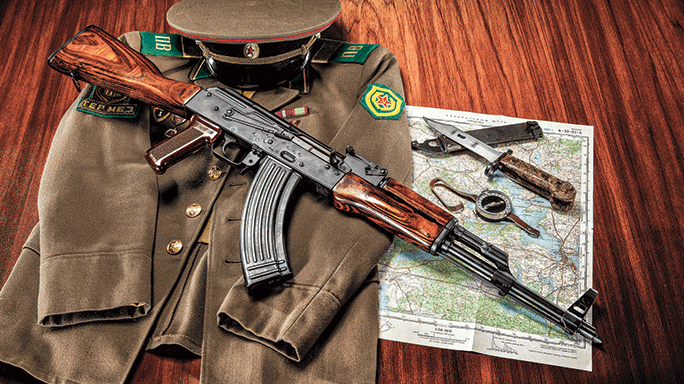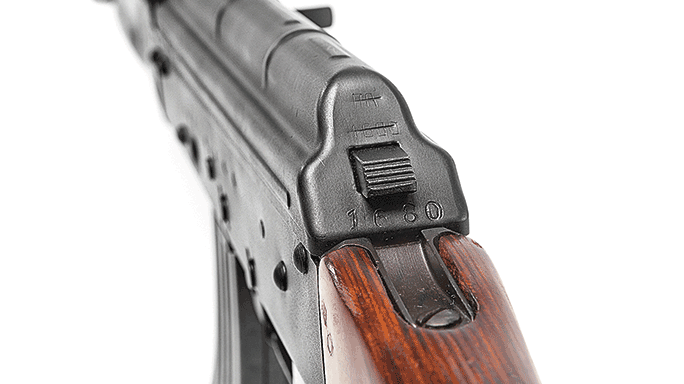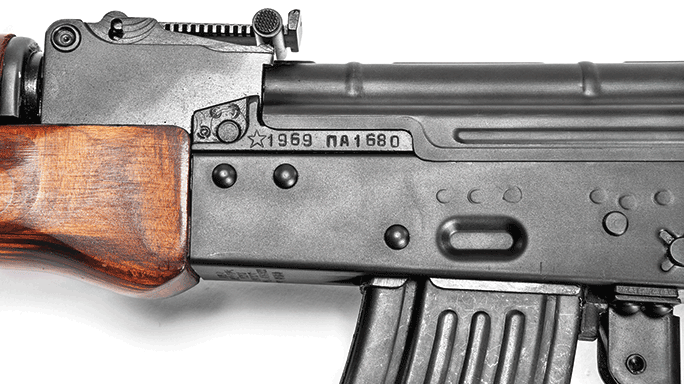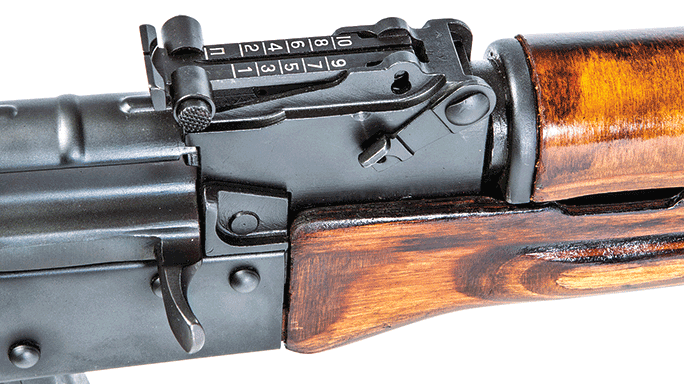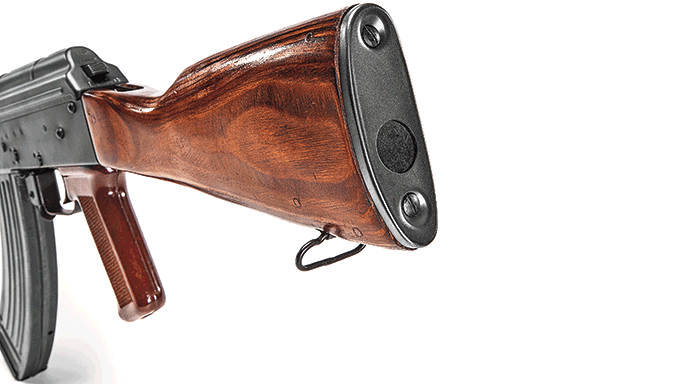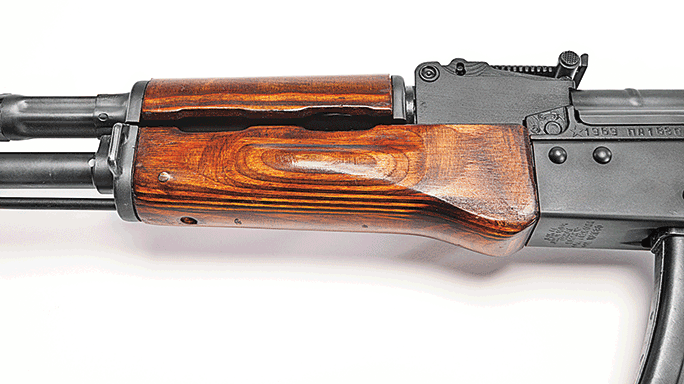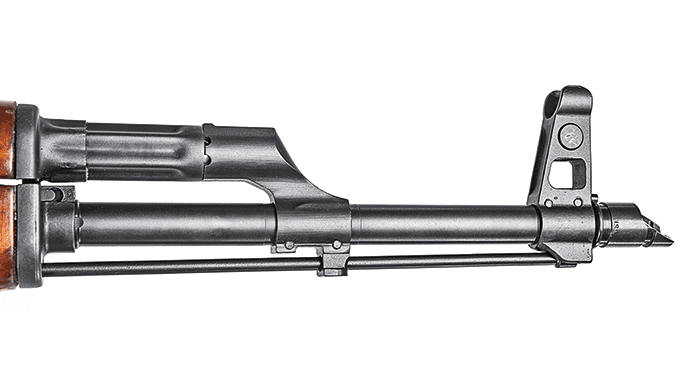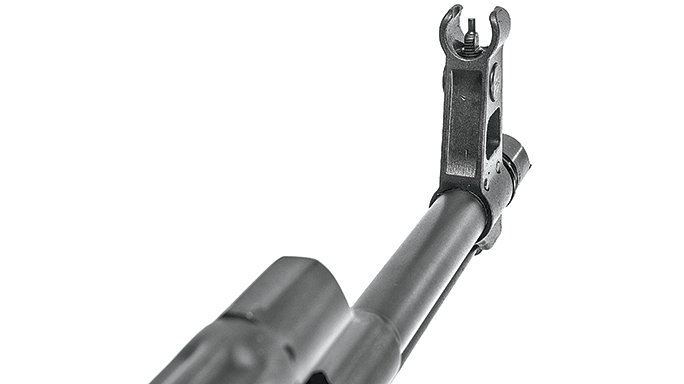The AK’s popularity in the U.S. is hard to refute, and it’s not going to be stemmed any time soon, though access to AK rifles is a growing concern. The days of plentiful imported AKs are over. Even during the surplus heyday, Russian/Soviet AKs were in short supply. Any visit to your favorite gun shop would have reinforced this statement via the Romanian, Bulgarian and Polish AKs present, but a dearth of Russian models.
- RELATED STORY: James River Armory AK47-JRA 7.62x39mm Rifle
The AK is an easy mark for politicians looking for gun-control credentials, with import restrictions easier to levy than pushing legislation through Congress. While there is no doubt that the AR-15 is the favorite among U.S. consumers, the AK has steadily grown its market share thanks to its reputation of reliability and ruggedness, all at a reasonable price point. Factors such as an effective cartridge available in bulk, utter reliability in harsh conditions, reasonable prices and sturdy, economical magazines make it hard to argue against selecting this rifle. Thank goodness for capitalism and a free market economy that rewards solid value no matter the genre of goods being sold.
While the ubiquitous term “AK” is used across the board to describe AK-pattern rifles, the AK has transitioned through various models if you will, stemming from production constraints and design tweaks. While Kalashnikov intended from the beginning for the AK to have a stamped receiver, there were difficulties during the initial phase of production.
Advertisement — Continue Reading Below
Metal stamping manufacturing for weapons was relatively new to the Soviets in the 1940s. This, combined with the country’s devastation as a result of World War II, created problems with refining AK production methods. Instead of halting production on the Kalashnikovs, a milled-receiver AK version was produced that took advantage of machines that were already present. Once Soviet stamping techniques were refined, the AKM (“M” for “modernized” in Russian) arrived in the late 1950s with a stamped receiver along with other design tweaks, including a reconfigured buttstock and pistol grip, and a slanted muzzle brake.
While U.S.-made AKs are growing in popularity in response to market impulses, there is still nothing that attracts AK connoisseurs more than a Russian-pattern AK. This is based on the relative rarity of Russian AKs even before our current import bans. James River Armory is offering a true gem to AK devotees with a recent find of squirreled-away, late 1960s issue Russian/Soviet AKM rifles. The rifle kits are from AKMs produced in the Izhmash and Tula factories, and feature matching serial-numbered parts for the bolt, bolt carrier, gas tube, trunnion, etc.
James River Armory fabricates a U.S. receiver for use with this Russian parts kit. Remember, due to import restrictions even before the current ban of Russian rifles, original AK receivers are demilled by getting cut in half. Other 922r-compliance parts consist of a U.S.-made, chrome-lined barrel, a TAPCO trigger group and a U.S.-made, slanted muzzle device. The rest of the James River AK is all original Russian—the bolt group, the front and rear trunnions, the stock furniture, the gas tube, sights and so on. What separates the James River Armory AK from competitors is the attention to detail that each rifle receives before leaving the shop. This includes wood furniture finishing as well as utilizing the Soviet-style hot salt bath to add a blued finish to the metal. The overall length of the James River Armory Russian AK is 35.25 inches and it weighs approximately 7 pounds.
Advertisement — Continue Reading Below
James River Armory is intimately familiar with the attention to detail that’s required when offering specific types of historical firearms as close to the original as possible in terms of manufacturing and price point. James River Armory opened its doors in 2002 with a focus on providing Civil War reenactors with realistic, functioning reproduction muskets. By 2013 its focus expanded into WWII weaponry, such as the M1 Garand and M1 Carbine. All of this experience is now brought to bear on the Russian/Soviet AKM rifle.
Going Hands-On
After a quick verification of the James River AK’s 25-yard sight zero, range evaluation commenced with a function test, which involved firing several magazines in rapid succession at the various man-sized steel targets that dot Echo Valley Training Center’s berms where I do my testing. While not unique, this is a good way to establish a baseline for reliability. The steel targets provide instant feedback when fired upon. This makes evaluations simpler versus firing at paper at distance and then viewing results later.
Advertisement — Continue Reading Below
Let’s face it, if an AK-type weapon does not have pristine reliability, its major attribute is nullified. I made sure different types of AK-47 magazines were used to further root out if any manufacturing quirks existed in the rifle. Metal and polymer 30-round magazines from various manufacturers performed fine during testing, exhibiting no issues being inserted, removed or while feeding the James River Armory AK. A more comprehensive 100-yard sight zero confirmation took place after functionality was established. This helps to confirm that the front sight base and rear sight are aligned correctly.
A new addition to the 7.62x39mm ammunition realm was accessed for testing with this AK. This is Century’s Red Army Standard and Elite brands. Red Army Standard and Elite 7.62x39mm ammunition is offered in handy Range Packs (180 rounds) as well as 30-round boxes. This packaging allows the consumer to purchase multiple boxes of ammunition in a convenient, easy-to-carry format.
This ammo is manufactured by the same factories that produced billions of rounds of ammunition for Warsaw Pact nations. Markings on the Standard and Elite Range Pack boxes indicated Romanian, Bosnian-Herzegovinan and Ukrainian manufacturing. With the recent import ban levied against Russian business concerns sure to impact Russian ammunition, Red Army Standard and Elite Ammunition is sure to fill the void. Other ammunition utilized with the James River Armory AKM consisted of Wolf’s 123-grain FMJ load and Hornady’s 123-grain SST.
Advertisement — Continue Reading Below
Accuracy with the James River Armory AK was more than acceptable, with the open sights producing 1.75-inch groups at 50 yards and 3.25 inches at 100 yards. I feel this is indicative more of my own eyesight combined with the basic form of the AK iron sights. This is supported by the fact that all ammunition tested produced similar results in terms of group sizes. The James River Armory AK does not feature an integral side scope rail, prohibiting the mounting of a magnified optic for more precise accuracy tests. Frankly, it was refreshing to revisit iron sights while conducting drills at the range while moving and firing behind simulated cover or vehicles.
Tactical Workout
I decided to concentrate on using the AK in training scenarios involving team tactics and patrolling to contact through Echo Valley’s 360 and Jungle Walk ranges. Sixty-plus years after its introduction, the AK still shines in terms of firepower and combat accuracy. Firing from unorthodox positions while working around range vehicles showed why the AK-pattern rifle is such an effective weapon.
Advertisement — Continue Reading Below
Not being a prisoner to a defined eye-relief distance offers a certain advantage with the iron sights. Strings of fire ranged from five rounds to 75 rounds with target distances measured in feet out to a couple of hundred yards. The James River Armory AK handled great, as it felt like a true carbine with perfect reliability. Magazine after 30-round magazine was inserted into the James River Armory AKM. No issues were encountered besides the forend getting hot from the hard use, just typical rugged/reliable AK performance. Over several range visits, I fired over 500 rounds without conducting any maintenance besides initial lubrication of the rifle when it arrived.
- RELATED STORY: Running Red: 20 Top AK-47s & Soviet Weapons
What more can be written about Mikhail Kalashnikov’s AK-pattern rifle? Its variants proliferate around the world and now are spreading across the land of its Cold War nemesis, the M16/AR-15. Growing AK popularity among U.S. civilians has spawned a burgeoning accessory market. While there is certainly nothing wrong with this, an AK in its pure form, such as the James River Armory Russian AKM, needs to be experienced to appreciate what the AK offered 60-plus years ago. Remember, the U.S.-issued rifle was still the venerated M1 Garand when the AK arrived on the scene. Many rifle models have come and gone while the AK-47 is still holding its own.
For more information, call 910-300-6462 or visit jamesriverarmory.com.
Advertisement — Continue Reading Below
AKM Specifications
- CALIBER: 7.62x39mm
- BARREL: 16.25 inches
- OA LENGTH: 35.25 inches
- WEIGHT: 7 pounds (empty)
- STOCK: Authentic Russian/Soviet wood furniture
- SIGHTS: Iron
- ACTION: Piston-driven semi-auto
- FINISH: Blued
- CAPACITY: 30+1
- MSRP: $1,200
